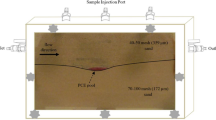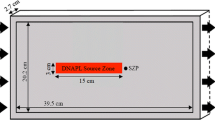Abstract
Chlorinated solvents generally enter the subsurface as dense nonaqueous phase liquids (DNAPL) and accumulation mostly occurs in aquifers as pool-dominated zones that can cause long-term aqueous phase groundwater contamination. In situ remediation of DNAPL source zones in such systems is crucial for protecting and/or restoring groundwater quality in these aquifer systems having significant groundwater potential. The objective of the project was to investigate the surfactant-enhanced permanganate oxidation efficacy for pool-dominated DNAPL source zones in heterogeneous aquifer media. A complementary objective of this study was to investigate the impact of nonuniform distribution of DNAPL source zones, surfactant-enhanced dissolution and surfactant-enhanced permanganate oxidation conditions on mass-flux reduction/mass-removal behavior relationships. A series of 2-D flow-cell tank experiments using various grain sizes silica sand and natural soil were conducted as part of this study. DNAPL trichloroethene (TCE) was used as a chlorinated solvent, and SDS (sodium dodecyl sulfate) and KMnO4 (potassium permanganate) were used as anionic surfactant and oxidant (remediation agents), respectively. The results were compared with a water-flooding experiment to test the remediation effort. Although, high fractions of TCE source zones in the heterogeneous porous media were removed by sodium dodecyl sulfate (SDS)-enhanced flushing, TCE removal in this system exhibited an extended multi-step concentration elution behavior. This nonideal behavior was observed for both the water-flood and SDS-flushing experiments. The results emphasized that in the early stage, some portion of the organic liquid is hydraulically accessible (matrix) whereas the later stage of mass removal was controlled by the more poorly accessible mass (pool) associated with higher saturation zones. Our results also showed that the distribution and the emplacement of organic liquid and flow-field heterogeneity had a significant influence on remediation and removal for both flushing solution (SDS and water). It was postulated that when SDS/MnO4 was applied with sufficient dosage and provided enough contact time, pool-dominated source zones could be remediated more efficiently compared to surfactant flushing alone. As a result, the performance of technology depends on the site characteristics which are critical to characterize effective DNAPL remediation strategies for contaminated sites.








Similar content being viewed by others
References
Akyol, N. H., & Turkkan, S. (2018). Effect of cyclodextrin-enhanced dissolution on mass removal and mass discharge reduction for TCE source zones in heterogeneous porous media. Water, Air and Soil Pollution, 229(30), 1–11.
Akyol, N. H., & Yolcubal, I. (2013). Oxidation of nonaqueous phase trichloroethylene with permanganate in epikarst. Water, Air and Soil Pollution, 224(1573), 1–19.
Akyol, N. H., Yolcubal, I., & Derya, I. (2011). Sorption and transport of trichloroethylene in caliche soil. Chemosphere, 82, 809–816.
Akyol, N. H., Russo, L. A., & Brusseau, M. L. (2013). Impact of enhanced-flushing reagents and organic liquid distribution on mass removal and mass discharge reduction. Water, Air and Soil Pollution, 224, 1731.
ASTM D 7262-07. (2007). Standard test method for estimating the permanganate natural oxidant demand of soil and aquifer solids.
Boving, T. B., & Brusseau, M. L. (2000). Solubilization and removal of residual trichloroethene from porous media: comparison of several solubilization agents. Journal of Contaminant Hydrology, 42, 51–67.
Brusseau, M. L., Nelson, N. T., Zhang, Z., Blue, J. E., Rohrer, J., & Allen, T. (2007). Source-zone characterization of a chlorinated-solvent contaminated superfund site in Tucson AZ. Journal of Contaminant Hydrology, 90, 21–40.
Brusseau, M. L., Matthieu, D. E., Carroll, K. C., Mainhagu, J., Morrison, C., McMillan, A., Russo, A., & Plaschke, M. (2013). Characterizing long-term contaminant mass discharge and the relationship between reductions in discharge and reductions in mass for DNAPL source areas. Journal of Contaminant Hydrology, 149, 1–12.
Bryant, D., Battey, T., Coleman, K., Mullen, D., & Wood, R. (2003). Permanganate in-situ chemical oxidation of TCE in a fractured bedrock aquifer. EPA-Groundwater Currents, 43, 1–2.
Conrad, S. H., Glass, R. J., & Peplinski, W. J. (2002). Bench-scale visualization of DNAPL remediation processes in analog heterogeneous aquifers: surfactant floods and in situ oxidation using permanganate. Journal of Contaminant Hydrology, 58, 13–49.
Crimi, M. L., & Ko, S. (2009). Control of manganese dioxide particles resulting from in situ chemical oxidation using permanganate. Chemosphere, 74, 847–853.
DiFilippo, E. L., & Brusseau, M. L. (2008). Relationship between mass flux reduction and source-zone mass removal: analysis of field data. Journal of Contaminant Hydrology, 98, 22–35.
DiFilippo, E. L., Carroll, K. C., & Brusseau, M. L. (2010). Impact of organic-liquid distribution and flow-field heterogeneity on reductions in mass flux. Journal of Contaminant Hydrology, 115, 14–25.
Dugan P. J. (2011). Coupling technologies for enhanced dense nonaqueous phase (DNAPL) mass removal, Carus Corporation Events.
Huang, K. C., Hoag, G. E., Cheeda, P., Woody, B. A., & Dobbs, G. M. (2002). Chemical oxidation of trichloroethylene with potassium permanganate in a porous medium. Advances in Environmental Research, 7, 217–229.
Julian, M. (2011). Modeling interphase mass flux between PCE and permanganate in the presence of surfactants, Theis Proposal, Clarkson University.
Kao, C. M., Huang, K. D., Wang, J. Y., Chen, T. Y., & Chien, T. Y. (2008). Application of potassium permanganate as an oxidant for in situ oxidation of trichloroethylene-contaminated groundwater: a laboratory and kinetics study. Journal of Hazardous Materials, 153, 919–927.
Li, Z., & Hanlie, H. (2008). Combination of surfactant solubilization with permanganate oxidation for DNAPL remediation. Water Resources, 42.
Mahal, M. K., Murao, A., Johnson, G. R., Russo, A., & Brusseau, M. L. (2010). Non-ideal behavior during complete dissolution of organic immiscible liquid: 2. ideal porous media. Water, Air and Soil Pollution, 213, 191–197.
Marble, J. C., Carroll, K. C., Januosek, H., & Brusseau, M. L. (2010). In-situ oxidation and associated mass-flux-reduction/mass-removal behavior for systems with organic liquid located in lower-permeability sediments. Journal of Contaminant Hydrology, 117, 82–93.
Russo, A., Mahal, M. K., & Brusseau, M. L. (2009). Nonideal behavior during complete dissolution of organic immiscible liquid: 1. Natural porous media, Journal of Hazardous Materials, 172, 208–213.
Stroo, H. F., Unger, M., Ward, C. H., Kavanaugh, M. C., Vogel, C., Leeson, A., Marqusee, J. A., & Smith, B. P. (2003). Remediating chlorinated solvent source zones. Environmental Science and Technology, 37, 224A–230A.
Tick, G. R., & Rincon, E. (2009). Effect of enhanced-solubilization agents on dissolution and mass flux from uniformly distributed immiscible liquid trichloroethylene (TCE) in homogeneous porous media. Water, Air and Soil Pollution, 204, 315–332.
Tick, G. R., Harvell, J. R., & Murgulet, D. (2015). Intermediate-scale investigation of enhanced-solubilization agents on the dissolution and removal of a multicomponent dense nonaqueous phase liquid (DNAPL) source. Water air and soil pollution, 226(11), art. #371. https://doi.org/10.1007/s11270-015-2636-7.
Tsai, T. T., Kao, C. M., Yeh, T. Y., Lianga, S. H., & Chiena, H. Y. (2009). Application of surfactant enhanced permanganate oxidation and bidegradation of trichloroethylene in groundwater. Journal of Hazardous Materials, 161, 111–119.
Zhang, C., Yoon, H., Werth, C. J., Valocchi, A. J., Basu, N. B., & Jawitz, J. W. (2008). Evaluation of simplified mass transfer models to simulate the impacts of source zone architecture on nonaqueous phase liquid dissolution in heterogeneous porous media. Journal of Contaminant Hydrology, 102, (1–2), 49–60
Zhai, X., Hua, L., & Rao, P. (2006). Cosolvent enhanced chemical oxidation of perchloroethylene by potassium permanganate. Journal of Contaminant Hydrology, 82, 61–74.
Zheng, F., Gao, B., Sun, Y., Shi, X., Xu, H., Wu, J., & Gao, Y. (2016). Removal of tetrachloroethylene from homogeneous and heterogeneous porous media: Combined effects of surfactant solubilization and oxidant degradation. Chemical Engineering Journal, 283, 595–603.
Acknowledgements
This research was supported by The Scientific and Technological Research Council of Turkey (Project No. 115Y117. I thank anonymous reviewers for their constructive comments.
Author information
Authors and Affiliations
Corresponding author
Rights and permissions
About this article
Cite this article
Akyol, N.H. Surfactant-Enhanced Permanganate Oxidation on Mass-Flux Reduction and Mass Removal (MFR-MR) Relationship for Pool-Dominated TCE Source Zones in Heterogeneous Porous Media. Water Air Soil Pollut 229, 285 (2018). https://doi.org/10.1007/s11270-018-3946-3
Received:
Accepted:
Published:
DOI: https://doi.org/10.1007/s11270-018-3946-3




